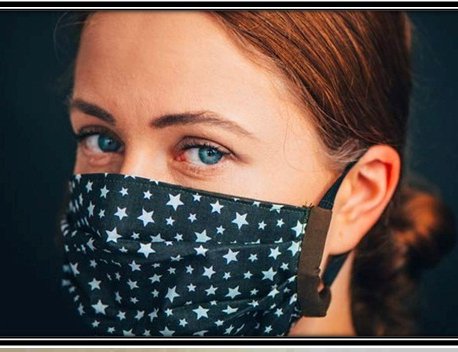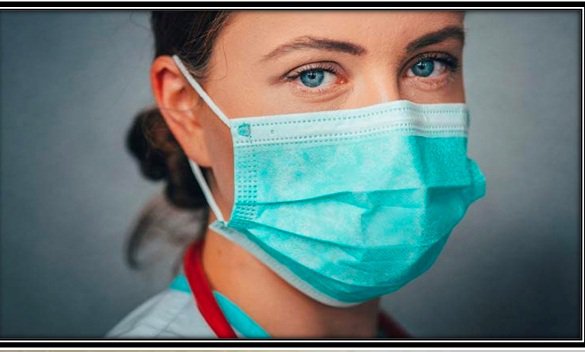
“Coronavirus is smaller than the filtering pores on the N95 respirator, so the N95 respirator doesn’t work, right? Not exactly!”
Fabric Face Coverings
Cloth face coverings are not manufactured to a recognized standard and they are not the same as the surgical masks or respirators. Research, conducted in Nepal last year, showed that the majority of locally available cloth face masks (having pore size 80 – 500 microns) may not be very effective in avoiding small particles (less than 10 microns). The study also revealed that repeated washing and drying of cloth mask deteriorates its efficiency. However, people who want to wear a face-covering in public and workplaces should be well encouraged to do so for the benefit of everybody. Several studies now indicate that wearing a mask, even a cloth face-covering in the time of wide community spreads when physical distancing is tough to maintain, can create a physical barrier to the coronavirus.
World Health Organization supports the use of fabric masks or faces coverings to prevent the spread of coronavirus. However, the evidential benefit of using a face covering is limited, therefore face coverings are not a replacement for other ways of managing risks in your homes and offices such as social distancing, reducing the number of people in the work area, minimizing time spent in contact, job rotations, increasing hand hygiene, and surface disinfection, etc.
Johns Hopkins Medicine also claims that wearing cloth face masks or coverings in public, when physical distancing can’t be maintained effectively, does offer protection against the spread of COVID-19. The evidence suggests that wearing a face-covering may not necessarily protect you, but it may protect others if you are infected and have not developed symptoms yet. On the other hand, if you are healthy, a face covering may as well protect you from larger infectious droplets from people around you.
Centers for Disease Control and Prevention reckons that a cloth face covering may not protect the wearer, but it may keep the wearer from spreading the virus to others. That means “YOUR cloth face covering may protect THEM and THEIR cloth face covering may protect YOU”.Let’s not forget that wearing a cloth face covering will especially help protect people who are at higher risk of severe illness from COVID-19 and workers who frequently come in close contact with other people (in shops, crowds, restaurants, and during transportation, etc.).However, cloth face coverings will only prove effective in reducing the spread of COVID-19 when they are widely understood, accepted and practiced by people in communities.
A face covering can be very simple and maybe worn in enclosed spaces as well as in crowded places where social distancing isn’t possible. It just needs to cover your mouth and nose. While wearing a fabric face-covering in public, make sure you can talk with your mask on and that it doesn’t irritate you. Otherwise, you may be tempted to pull it out of place or touch your face and limit its effectiveness altogether.
Surgical Face Masks
Unlike face coverings, surgical face masks are manufactured to a recognized standard and can be effective in blocking splashes and large-particle droplets. However, they do not filter or block very small particles in the air. Moreover, both face coverings and surgical masks do not provide complete protection from germs (viruses and bacteria) and other contaminants in the immediate environment because of the loose fit between the surface of the mask or covering and your face. You may notice that the edges of surgical masks are not designed to form a seal around the nose and mouth.

Surgical face masks are not to be shared and are normally designed to be worn in medical settings to limit the spread of infection. If worn properly, a surgical face mask is meant to help block large-particle droplets, splashes, sprays, or splatter from reaching your mouth and nose. They also protect patients from the wearer’s respiratory emissions. If your mask is damaged or soiled, or if breathing through the mask becomes difficult, you should discard it safely and replace it with a new one. Do not forget to wash your hands after handling the used mask.
The particle capturing capacity of the filter (nonwoven mats of fine fibers) used in modern surgical masks largely depends on its fiber diameter, porosity, thickness, etc. Due to the same characteristics, the performance of surgical face mask is superior to that of a cloth face covering. However, the filtration mechanism of a surgical mask does not provide the wearer with a reliable level of protection from inhaling smaller airborne particles (less than 2.5 microns). Therefore the surgical face mask should not be considered a respiratory protection device.
N95 Respirators
A respirator, such as an N95 respirator, is a respiratory protective device designed to achieve a very close facial fit and very efficient filtration of small airborne particles. N95 respirators are capable of filtering out all types of small and large particles protecting you from exposure to biological aerosols including viruses and bacteria.On the other hand, surgical N95 respirators are commonly used in healthcare settings and are a subset of N95 respirators.A surgical N95 respirator (also referred to as a medical respirator) is recommended only for use by healthcare personnel who need protection from both airborne and fluid hazards such as splashes, sprays, etc.

The N95 designation means that when subjected to careful testing, the respirator blocks at least 95% of very small (up to 0.3 microns) particles. However, coronaviruses are even smaller in size (0.065–0.125 micron in diameter) and contain a single-stranded RNA as a nucleic material. Therefore, the virus is smaller than the filtering pores on the N95 respirator, so the N95 respirator doesn’t work (can’t sieve out coronaviruses), right? Not exactly!
To understand this concept first we need to know a few basic principles pertaining to the behavior of viruses.“There is never a naked virus floating in the air or released by people”. The COVID-19 particle is indeed around 0.1 micron in size, but it is always enveloped by something larger. For example, when a COVID infected person breathes, talks, coughs, etc., the exhaled viruses tend to attach to small droplets or aerosols (consisting of water, mucus protein and other biological materials from inside the infected person) which are all larger than 1 micron. Therefore, activities such as breathing, talking and sneezing generate particles around 1 micron in size, which can be efficiently collected by N95 respirator filters.
Although the N95 respirator filter is 0.3-micron size, it works even better for particles smaller than the 0.3-micron threshold. This is because the N95 respirator filter does not only work by sieving out larger particles. However counterintuitive it may sound, scientists have valid explanations for this. Firstly according to the principle of “Brownian Motion”, particles smaller than 0.3 microns move in an erratic or zig-zag kind of motion increasing the possibility of them getting trapped by the filtering fibers. Secondly, due to the electrostatic attraction generated by the N95 respirator itself, particles smaller than 0.3 microns are drawn to the charged fiber and get stuck there, instead of just passing through the filtering pores. When the electrostatic charges are dissipated during extended usage and storage, the capability of stopping virus-sized particles (around 0.1 microns) diminishes. This is why repeated use of the N95 respirator is not recommended.

Amit K. Shrestha
Shrestha is a freelance Consultant, MS in Risk Control & Safety Management; The author is passionate about the issues involving environment, occupational health, safety and sustainability for the planet, people and profit. Contact Email: OHSNepal@gmail.co
- Preventing Rapid Climate Change: A Hugely Complicated Taskfor Humanity To Tackle
- Oct 29, 2021
- Changing Perception Changes Everything: A Paradigm Shift In Consciousness
- Aug 02, 2021
- Business Continuity Planning And Disaster Recovery: NRB Guidelines For Commercial Banks of Nepal
- Jun 23, 2021
- Fighting Covid-19: Emotional And Mental Wellbeing Of Essential And Frontline Workers
- May 23, 2021
- Fearsome-4 of Construction Industries: Focus on Fatal-Four Hazards
- Jan 27, 2021












